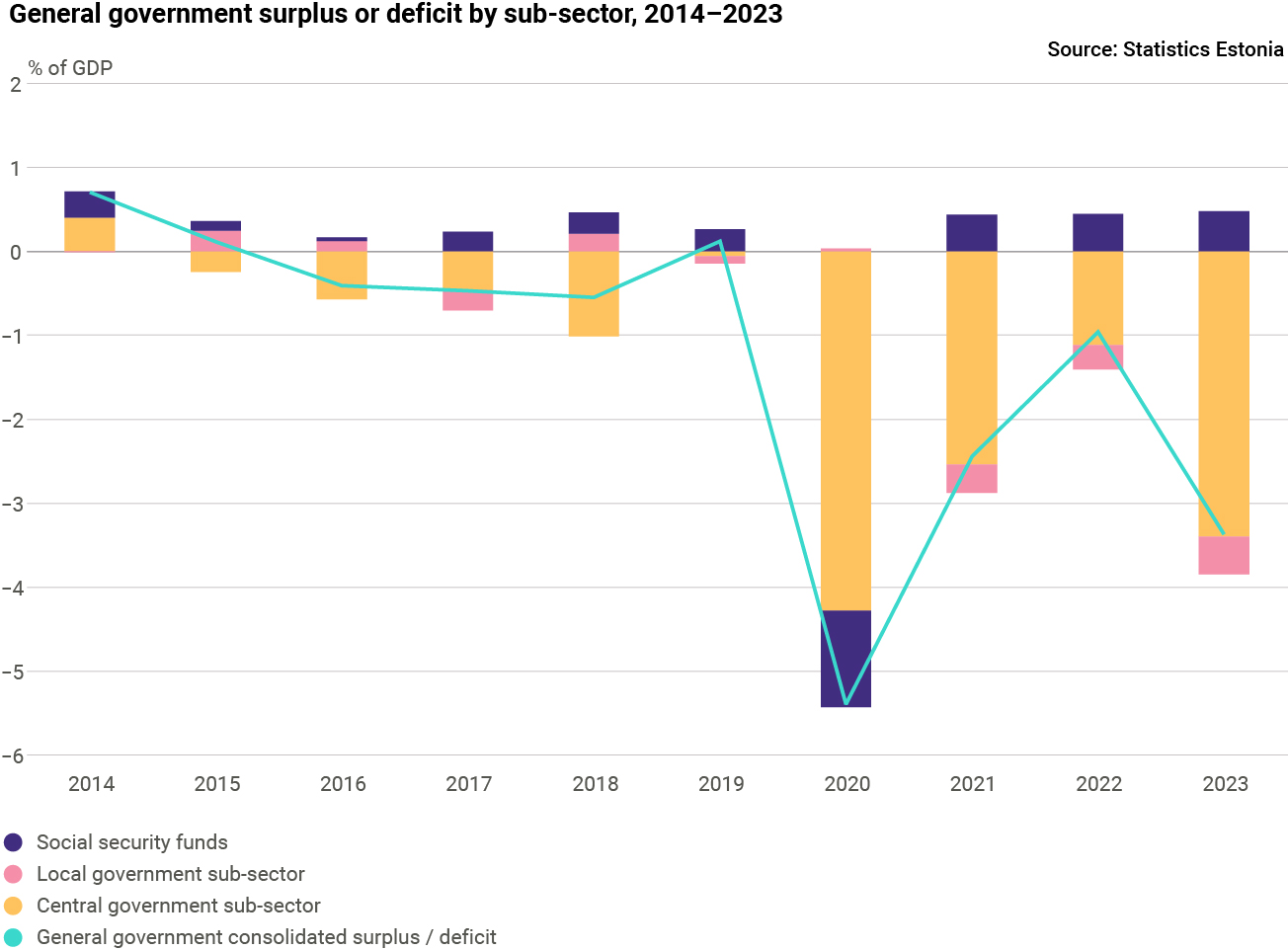General government deficit and debt increased last year
According to the preliminary* data of Statistics Estonia, in 2023, the Estonian general government deficit was 3.4% and the debt level was 19.6% of the gross domestic product (GDP). At the end of last year, the total expenditures of the general government exceeded revenues by 1.3 billion euros.
In Estonia, the general government sector comprises three sub-sectors: central government, local governments, and social security funds. The central government sub-sector includes state budget units, foundations, and legal entities governed by public law. The local government sub-sector includes city and rural municipality governments with their subsidiary units, and foundations.
Pauline Kommer, team lead of government finance statistics at Statistics Estonia, said that both the central government and local governments ended 2023 in deficit. “The deficit was 1.3 billion euros for the central government and 170 million euros for local governments,” added Kommer.
Compared with 2022, general government revenues grew by 8.2% and expenditures by 14.5%. Thus, expenditures exceeded revenues by 1.3 billion euros, resulting in a budget deficit that was 3.4% of the GDP in 2023.**
The deficit had decreased in 2022, but in 2023 the deficit widened in the central government and local governments. The larger deficit was mainly due to increased defence expenditures. Labour costs also increased, as did the central government investments and expenditures on social benefits (primarily pensions and family allowances). Higher labour costs also meant increased revenue from labour taxes, which boosted government revenues. Social security funds were the only sub-sector to end 2023 in surplus, as their revenues exceeded expenditures by 181 million euros.
The general government consolidated debt (Maastricht debt***) increased and amounted to 7.4 billion euros by the end of 2023, which corresponds to 19.6% of the GDP. Both the central government and local governments contributed to the rise in debt. Looking at debt instruments, the biggest increase occurred in the volume of short-term and long-term debt securities, which were up by 171 million euros (49%) and 490 million euros (19%), respectively. The level of long-term loan liabilities did not rise significantly (up by 80 million euros, or 2%). Compared with 2022, the general government debt to GDP ratio rose from 18.5% to 19.6%.
A closer look at the debt level of sub-sectors reveals that the total debt of the central government grew by 11% year on year, amounting to 7.5 billion euros by the end of 2023. The volume of debt securities increased the most (by 23%) as the government issued additional short-term treasury bills in 2023 and raised the volume of 10-year government bonds issued in 2022 by 500 million euros. At the end of 2023, the volume of debt securities was 3.6 billion euros (up from 2.9 billion euros at the end of 2022). The volume of long-term loan liabilities decreased slightly, reaching 2.6 billion euros at the end of last year (it was 2.7 billion euros at the end of 2022). Foreign debt, i.e. liabilities towards the rest of the world, accounted for 71% of the central government’s loan liabilities. The central government’s liabilities towards social security funds increased to 1.3 billion euros.
The local government consolidated debt was 1.1 billion euros at the end of 2023, up by 15% year on year. The greater consolidated debt was due to the 18% increase in long-term loan liabilities. The volume of long-term debt securities continued to decrease and was down by nearly a fifth compared with 2022. The share of foreign debt remained the same year on year and stood at 27% of local government debt.
Social security funds (i.e. the Estonian Health Insurance Fund and the Estonian Unemployment Insurance Fund) did not contribute to general government debt.
See also the government finance section on our website.
More detailed data have been published in the statistical database.
When using Statistics Estonia’s data and graphs, please indicate the source.
For further information:
Kai Kaljumäe
Communications Partner
Marketing and Dissemination Department
Statistics Estonia
Tel +372 625 9184
press [at] stat.ee (press[at]stat[dot]ee)
Photo: Shutterstock
*Revised data on government finance statistics will be published in September 2024.
**Data on the general government surplus/deficit and consolidated debt as a share of GDP can be found in table RR061 in the statistical database.
***General government debt, or Maastricht debt, refers to the liabilities of the general government units in the following categories: currency and deposits, debt securities and loans. In other words, the general government debt shows how much the state has borrowed and to what extent it holds the funds of other units. The debt is calculated without interest liabilities.
